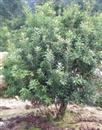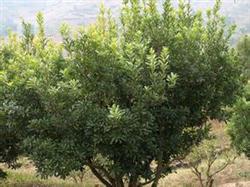Species and integrated control of main pests in Myrica rubra

Red bayberry not only has high medicinal and edible value, but also is an excellent evergreen leaf and fruit tree species. According to statistics, the total cultivated area of red bayberry in China has exceeded 213000 hectares. However, while planting in a large area, red bayberry suffers from a variety of pests due to poor management and other reasons, resulting in serious economic losses. 1. Main pest species 1. Piercing and inhaling. ① cypress oyster scale. If the scale and the female adult scale are fixed on both sides of the main vein of the leaf and on the 1-year-old or 2-year-old twigs, the leaves lose luster, turn brown and die gradually, and the sucked branches will gradually dry up and die, which leads to the weakening of the tree, the decline of fruit yield and quality, and the death of the whole tree when the damage is serious. Two generations occur in Zhejiang, Nanjing and other places in a year, and the damage period is from June to September. ② camphor net shield scale. The main veins, tender shoots and petiole bases of leaves were damaged by female adult scale and nymph, sucking their juice and causing coal fouling disease. When the damage is mild, yellow spots appear in leaves and other tissues, affecting its photosynthesis and yield; when the damage is serious, leaves often wither or even die. There are two generations a year in Zhejiang, and the peak period of damage is from mid-May to mid-July and from mid-September to late October. ③ oyster scale. If the scale and adult scale cluster on the branches and trunks of more than 2 years old to absorb juice, so that the plant can not grow so well that it can not conceive buds and blossom, the epidermis of the damaged branches is often wrinkled and easy to break, and the seriously damaged branches dry up and die. There are 1 or 2 generations in a year, and the peak period of damage is from early June to early July. two。 Chewy. ① tea coir moth. Because of its aggregative distribution, there is an obvious damage center. The larvae bite the leaves, tender shoots or peel off the branches and fruit cortex in the bag, resulting in local branches and baldness. The occurrence of algebra varies in different places, mainly two generations in one year, and the peak period of damage is from July to August. ② oiltree inchworm. The 1st and 2nd instar larvae like to feed on the epidermis and mesophyll from the leaf edge or leaf tip, the 3rd instar larvae become notched after damage, and the whole leaves can be eaten after the 4th instar. Algebra varies from place to place. ③ small yellow leaf roll moth. The larvae spin silk on the tender leaves, fix the adult buds of the leaves, and feed on them. The damage to the new shoots of red bayberry affected the normal growth and development and leaf photosynthesis. When the damage is serious, the new shoots are reddish brown and scorched. The occurrence algebra is different in different regions. 3. Dry borer. ① small wood bark beetle. Wormholes and yellowish-white excreta can be observed on the tree trunk after being killed, and the damaged part smells of water. After the red bayberry was killed, the new shoots were rare, the tree potential declined significantly, a large number of fallen leaves appeared in serious cases, the yield decreased, and even the tree declined. There are 1 or 2 generations in a year. ② longicorn beetles. The larvae can damage the xylem and roots at the base of the trunk, and the adults feed on the leaves, resulting in the absence of leaves. Algebra varies from place to place. Second, comprehensive prevention and control. Agriculture and physical control. Combined with agricultural operations such as pruning and pruning, larvae, pupae, cysts and heavily damaged insect branches are removed; more phosphorus and potassium fertilizers are applied to enhance the tree's resistance to insect pests; most adults have phototaxis and can be trapped and killed by hanging black lights at night; adults such as longicorn beetles like to climb to the bottom of the tree trunk to lay eggs and have pseudo-death, which can be used to artificially kill adults and eggs. According to the freshness of the excreta outside the exhaust hole of stem borer, the methods such as wire hook were used. two。 Biological control. Biological control mainly depends on the protection of natural enemies. The main natural enemies of piercing and sucking pests are red round scale golden aphid wasp, purple oyster scale yellow aphid wasp, double-band giant horn jumping wasp, single-band giant horn jumping wasp, red-lipped ladybug, Japanese ladybug and so on. The main natural enemies of chewable pests are coir moth verrucous wasp, pine caterpillar verrucous wasp, mulberry verrucous wasp, thigh wasp, black egg wasp and parasitic fly. The main natural enemies of dry borer pests are parasitoids, ants, birds and so on. In addition to the use of natural enemies, it can also be controlled by fungi, bacteria and viruses. 3. Chemical control. When the damage of pests is serious and manual removal can not solve the problem, chemical control can be used. The principle of prevention and control is to choose chemicals with high efficiency and low toxicity, pay attention to the combined use of many kinds of agents, and can not use a single agent for a long time. ① piercing and suction. During the peak incubation period, 50% fenitrothion EC 1500 times, or 25% quinathion EC 500 times 1000 times, or 20% buprofezin EC 1500 times 2000 times, or 28% Cobao EC 1200 times, etc., can be used for spray control. ② chewable type. Tea coir moth: the larvae were sprayed with 50% malathion EC 1000-1500 times, or 0.3% hypertonic avermectin EC 1500-2000 times, or Bacillus thuringiensis wettable powder 500 times. Paulownia inchworm: at the initial stage of larval damage, 10% permethrin, or 35% endosulfan EC 2000-3000 times, or 10% bifenthrin EC 5000 times, etc., were used for control. Small yellow leaf moth: the larvae were controlled with 1000 times of fenitrothion EC at the initial stage of damage to the larvae. ③ borer dry. Small wood beetle: brush the affected area with 48% chlorpyrifos EC 1000 times, or 48% chlorpyrifos EC + waterproof paint 5 times 10 times. Anoplophora glabripennis: cotton is dipped in dichlorvos and blocked with mud, and the control effect is very good; according to the habit of feeding on tender leaves during the period of adult damage, spraying 25% carbaryl wettable powder 1.5-3.75 kg / ha during the peak period of adult Eclosion has a good control effect.
- Prev

Pruning methods of fruitful Waxberry trees
The fruit trees without shaping were pruned with large branches, sawed off the upper erect branches, crossed branches of the two trees, ground branches in the lower part, dense branches in the crown and overlapping branches. For multiple twigs on a branch, the upper part of the crown should remove the strong branch and leave the weak branch, and the lower part of the crown should remove the weak branch and the strong branch. Sparse the crowded branches on the outside.
- Next

Causes and Control methods of empty Bud of Castanea mollissima
Causes and Control methods of empty Bud of Castanea mollissima
Related
- Moge, come on! The staff of the peasant association in the producing area of cantaloupe were frightened when the crowd gathered.
- Causes and Solutions of low Fruit setting rate of Apple
- Symptoms and control measures of passion fruit virus disease
- Fruit growing lesson: how do apple orchards keep high yields?
- Can you build orchards in the mountains? What are the pros and cons?
- How to manage the coloring period of Crisson grape?
- This paper introduces the processing technology of two kinds of fig products.
- How much is a month for retired teachers in rural areas by 2020?
- How can strawberry planting increase sugar content? We should pay attention to management in many aspects.
- What are the cultivation techniques on how to improve the yield of golden fruit?

